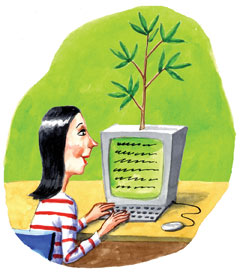Green IT is the practice of using information technology procedures, products and services in an environmentally responsible manner. Green IT goes beyond greener web hosting. It means that anything related to computing – from designing, manufacturing, using and disposing, is done with minimal impact to the environment.
By adopting green IT initiatives, businesses can become greener and significantly reduce their environmental footprint. But the main reason why Green IT is catching on, is however, not due to the sudden eco-enlightenment of big business. Skyrocketing energy bills, expanding carbon footprints, and other environmental woes cost businesses big money, and greening IT can result in big savings. So big that Forrester research predicts that the Green IT consulting market will hit $4.8B by 2013.
So, Why Do We Need Green IT, Really?
Global emission of carbon dioxide from IT is said to equal the emissions produced by the airline industry. Imagine its contribution to global warming!
In an average office, IT alone consumes more than 30 percent of the electricity used. We can opt for green IT by switching over to low energy servers and hosting equipments that consume less energy. Little changes like switching to LCD monitors from the CRT ones that are notorious for their energy consumption, makes quite a significant difference. When we’re throwing out the old equipment it’s a good idea to get it recycled by some transparent e-waste management agency, like GreenCitizen. It’s also important to employ power management features that automatically turn off hard drives and displays after a certain period of inactivity.
Benefits of Green IT
With the carbon dioxide emission consequences of IT exceeding that of the airline industry, the the adoption of green IT initiatives by business around the world can have a significant impact. But greening corporate IT infrastructures not only benefits the planet, it benefits the company as well:
- Green IT can significantly reduce energy costs
- Green IT can reduce operational costs and increasing efficiency
- Green IT can positively impact employee loyalty towards working in a company with strong CSR values
- Green IT can improve customer loyalty as people like to do business with companies that are environmentally conscious
Green Computing Versus Green IT
Green computing and green IT are closely interlinked but they are not the same. Green computing is about using computer resources efficiently whereas green IT is not just about computing, it also includes management strategies, procedures, supporting green business as well as energy efficiency. There are two kinds of technologies when it comes green IT. According to Forrester Research, the first is ‘green IT 1.0′ that deals with the green infrastructure of the industry like virtualization and power management. The second is ‘green IT 2.0′ that deals with helping businesses go green by focusing on aspects such as video conferencing or supply chain management software.

How to Have a Green Impact on IT
Early initiative towards green IT took place in 1992 with the formation of the voluntary labeling program known as Energy Star by US Environmental Protection Agency, which was designed to promote and recognize climatic control devices, energy efficient monitors and other environmental friendly technologies. Today, the Energy Star label is commonly found in PCs, laptops and monitors.
Governmental agencies all around the world are taking steps to encourage green computing, but it is not just the responsibility of governments but also of individuals and private organizations. The working habits of any computer user and business can be modified to adopt green IT as a general practice. Here are a few integral ways to promote green IT:
Virtualization– through virtualization, several physical systems can be combined on one single powerful system; this will allow original hardware to be unplugged, which will result in reduced cooling needs and power consumption. Several companies are now switching to virtualization, such as Intel and AMD.
Telecommunicating– Thanks to video conferencing workers can telecommute as well as hold long distance meetings without sharing physical space. It offers plenty of benefits such as significant reduction of overhead costs for office space, lighting etc. It is easier to communicate with the client without physical presence being a requirement and enhances worker satisfaction.
Power management– Power consumption can be reduced by putting in a system that automatically turns off hardware and monitors after a set period of inactivity, this will allow significant reduces in electricity consumption and heat.
Paper reduction– Email reduces the use of fax machines and consequently saves paper. Discourage printing of papers and encourage the use of electronic documents as it will eliminate usage of toner and paper. Keeping electronic records also saves the company from a significant paper trail.
Green Data Centers
If you run a business, odds are that you’ll either have a data center of your own, or are using/renting one off-site. Data centers are the backbone of a company. It is where a business stores, organizes and backs up its data on servers. The core asset of any organization is its information, and keeping it running 24/7 with less than 1% downtime allowance is critical to survive.
The servers in data centers consume energy on two ends: servers and cooling. The servers run 24/7 consuming the energy they require to do their job. Because the servers are online all the time, the machines tend to get hot and this creates a potential safety hazard as well as increases the chances of machines breaking down sooner. To avoid this, heavy cooling systems are installed in the data centers to keep the servers cool and running. Incidentally, this cooling system usually consumes more energy than the servers themselves.
Because cooling is also a 24/7 job, the energy consumption is formidable especially when it is combined with the consumption of the servers and other related equipment.
Having said all that, not only does a greening data center save energy but it also lowers operational costs. Listed below are a few key points from a recent report released by Research and Markets in August 2009 that highlight the importance of turning our data centers green.
- Switching to ‘green’ energy-efficient PCs and turning PCs off at night would equate to annual savings of around £305,000 for a typical FTSE 200 company.
- Computers with ‘sleep’ mode use 60% to 70% less energy than PCs without, equating to $15-$40 savings in energy costs per PC per year.
- Worldwide data centers waste 875m kWh of energy every year an equivalent to 436m kilograms of CO2. The number of servers in data centers is increasing annually by 18%.
- Virtualization of servers in the data center can boost efficiency, dramatically cut power consumption, and result in significant cost savings.
At the end of the day, greener IT not allows you to relieve any guilt over your IT infrastructure causing global warming, it can lower your operational costs and add to your business bottom line.
____________________
Lorna Li is an expert in internet marketing for sustainable brands. To learn more about her work, visit LornaLi.com and this article.
To check out more Green Marketing TV articles visit http://www.greenmarketing.tv
Follow us Twitter.com/NobleProfit
Register at Noble Profit to gain valuable insights in related topics.
Noble Profit is brought to you by Creative Entity Org and Creative Entity Productions created by Amy Seidman.


 Noble Profit™ is an authentic source for discovering innovation, trends and investment in clean tech, and sustainable business.
Noble Profit™ is an authentic source for discovering innovation, trends and investment in clean tech, and sustainable business.